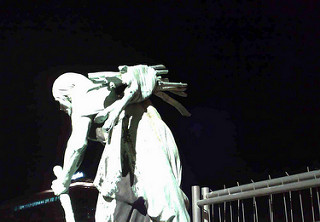 This post is the last of a three-part series that is not strictly about community engagement. However, to engage with communities with which one is not familiar it is essential to understand the dynamics of privilege. This is especially true when the “engager” is as directly viewed as a representative of wealth and power as is the nonprofit arts establishment. (You may find the complete essay here: Privilege/Encumbrance.)
This post is the last of a three-part series that is not strictly about community engagement. However, to engage with communities with which one is not familiar it is essential to understand the dynamics of privilege. This is especially true when the “engager” is as directly viewed as a representative of wealth and power as is the nonprofit arts establishment. (You may find the complete essay here: Privilege/Encumbrance.)
Last week’s post (Privilege/Encumbrance: Part II) dealt with the issue of socio-economic and identity privilege and encumbrance.
Structural Privilege/Encumbrance
Perhaps the most difficult aspect of the privilege/encumbrance question is structural inequity. It can exist without any bias or malice, although Jim Crow laws in the U.S. and apartheid in South Africa were structural and clearly were a manifestation of extreme bias.
The earlier discussion of nonprofit boards is one example of a structural inequity. Hiring requirements that demand a college or advanced degree can be another. (Access to degrees is socio-economically skewed. The well-off are far more likely to be able to avail themselves of this advantage.) The requirement of completion of a college degree for job applicants excludes those for whom higher education is unavailable. Perhaps it is not the only viable means of demonstrating capacity to do a job. Whether some other indicator might also be of value is a question worth asking and one that could arguably open up opportunity to some who would otherwise not be considered–to their and to the organization’s detriment.
Similarly, unpaid internships benefit those from households with higher socio-economic status without the specific intention of doing so. They provide experience and access to vital career connections but are wholly unavailable to students who must work long hours to pay the bills associated with college expenses.
“How well will they ‘fit in’?” is often an unconscious criteria in hiring processes. It gives advantage to those who are like those already in the workplace. If most of those are men, straight, white, upper middle class, etc. this is a roadblock for those who are not. It’s important to emphasize that this is frequently not conscious. It’s “just the way things are”–a structural barrier.
Structural inequities can be notoriously difficult to recognize. They are almost inevitably invisible to those who have benefited from them. In order to ferret out these burdens, it is often necessary to get advice from members of target groups; but even then, the encumbrance can be so deeply embedded in the structure as to be invisible to them as well. Yet, the burdens exist and are a stumbling block for or barricade against members of target groups.
Conclusion
For some of its beneficiaries, acknowledging privilege is not difficult to understand. The response is simply to recognize how often and in how many ways they gain from it and to work to make things more equitable. For others, deep awareness of the privileges that they do not enjoy makes it difficult to see that they hold advantage in comparison to others. This is why it may be productive to frame at least some of the discussion as burdens which some do not have to bear. Empathy may be more readily felt if we can focus on the relative disadvantage of others.
Privilege in the form of a relative lack of encumbrance exists. The playing field is extremely “unlevel.” While opportunity exists and success is possible in spite of inequitable burdens, those burdens winnow out large numbers of people. Pointing to the success of the extremely extraordinary individual does nothing to support the “merely” extraordinary who can’t overcome the obstacles; and it certainly does not provide equal opportunity for the “ordinary” person struggling to make it in an exhausting world. Losing access to the talents of those people denies society the benefits of the contributions they could make.
Working with any community that is subject to one or more of society’s isms requires an awareness that those isms have a huge impact. It also requires a willingness to factor that into the relationship building process. This is especially true for nonprofit arts organizations attempting to engage with diverse communities. They are, in the eyes of many, archetypical symbols of privilege.
Engage!
Doug
- Photo:

 Some rights reserved by St.A.
Some rights reserved by St.A.

[…] Privilege/Encumbrance: Part III This post is the last of a three-part series that is not strictly about community engagement. However, to engage with communities with which one is not familiar it is essential to understand the dynamics of privilege. … read more AJBlog: Engaging Matters Published 2017-01-31 What is classical music? We need a new audience. But how are we going to get one if we can’t tell people why classical music is valuable? And how can we do that if we don’t know what classical music is? (Dictionaries don't help.) […] Read More […]